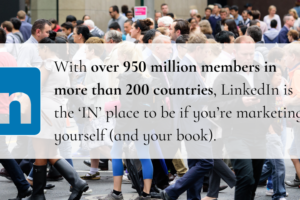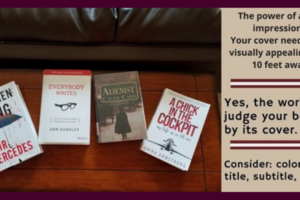Your Author Brand: How To Make It Stand Out
I’ve been talking to a lot of new writers who are interested in writing a book. We discuss their idea, if it’s nonfiction, and their plot, if it’s fiction. 💮
During our calls I always touch upon the idea of an author brand. 🌟
It wasn’t until I became a book coach and developmental editor that I even realized authors need a brand. Let me rephrase that, I didn’t realize that authors are a brand. As soon as you commit to that book, you begin building a brand that sets you apart from the crowd. 😎
I’m not talking about the business most of my authors are in – yes, there is a brand there, and the book will become part of it. 🌍
I’m talking about the book and the author together as a brand. An author brand. 🟪⚪🟪
In his book, Brand Intervention: 33 Steps to Transform the Brand You Have Into the Brand You Need, David Brier says,
Brands can no longer just “get by.” Brands today must be relevant, distinct, real, definitive, and not entirely predictable. Anything less demands an intervention.
David Brier, Chief Gravity Defier at DBD International
I totally agree about the intervention. We’ve performed a number of them at Master Book Builders. 💥
An author brand is a unique animal. If an author is in business, the author brand must reflect that business. But an author brand is also separate from the business. In essence, it can and should mimic the business while being able to stand on its own. 🧍♀️🧍♂️
My branding friend, Nick McGraw, who designed our logo, had this to say about author branding:
“Yvonne is right. You need to distinguish between business branding and author branding, as each targets different aspects of audience connection.
“Business branding involves creating an identity for a company’s products or services. Logos, visuals and the overarching narrative aiming to resonate with a specific customer.
“Author branding is more personal and introspective. It’s about the person, the author — their beliefs, experiences, and unique voice. Their personal journey and ethos. This personal connection is what differentiates author branding from business branding.
“If I wanted to know more about your company, I’d Google it. Being an author is an invitation for fans to get to know you more. I don’t need a book of business practices; I’d rather know what makes you tick.”
Nick McGraw of McGrawsome Design
Let’s discuss the elements of your author brand and how creating a good author brand can help you stand out from the crowd. 🌞
Your Author Bio 👩
In truth, this should say “bios,” plural. You should have several bios. A short one for short introductions on podcasts and the back of your book, around 150 words. A longer one for your author page on Amazon, perhaps, 300 words. And an extensive bio for your author website or webpage.
Your bio serves to be that first introduction of you, the person behind the book. It should be concise but captivating. Share your author’s journey, expertise, and passion.
This is not the same bio you have on your business About page. Your author bio should be more personal and inviting. Tell me why I should connect with you. (NOT why I should buy your book – that’s for your marketing – your bio is a glimpse into your life and purpose.)
Your Photo. Yes, You Need a Photo. 📸
I personally like having an author’s photo on the cover of their book. We have two books coming out soon with the author’s photo on the cover. It conveys expertise, confidence, and approachability.
This too should be plural, as you will need several photos. A professional headshot. A relaxed, here’s what I do at home, shot. A look at me, I’m taking a hike, shot (if you hike). And, yes, a photo with your dog. Or cat. Or whatever pet you have.
Bring out your personality in your photos. Here’s a photo of me that I’m not entirely fond of, but it’s in my former Colorado home, with my dog, Emily, who is no longer with us. I am so glad I have it! (Yes, I was a redhead at the time!)

Your Author Website 🕸
It goes without saying that you need a website that reflects your writing. You may have it attached to your main business site, but within your author website there are a number of elements required to support your author brand.
This post, written by Tom, outlines the 7 Essentials of Author Websites. I recommend you read it and take notes. Pay attention to the “Nice to Haves” he includes at the end.

Social Proof ✅💗✨😊
We live in an age of social proof. Get used to it.
Too many authors I talk to are saying they just don’t ‘want’ to do Instagram, or TikTok, or Facebook. They have their reasons, and all are valid, but if you do not engage on social media, you risk being invisible to a large part of your audience.
Shayla Raquel, in her book The 10 Commandments of Author Branding puts it succinctly:
THOU SHALT NOT TAKE THE NAME OF SOCIAL MEDIA IN VAIN (Chapter IV)
We do not use billboards. We do not broadcast on the radio. We do not hand out flyers. We use Facebook ads. We use podcasts. We use Instagram.
Social media – Tom and I call it “social networking” – is just a fact of life if you’re an author, today. Get friendly with it. Choose the one or two platforms you know you can kill it on, and kill it. Hint: Instagram should be one of them.
NOTE: One thing I caution you on regarding social media is bombarding people with your book. Don’t do it. “Hey, look, I wrote a book!” is childish and annoying. Instead, read this post and tell us how you wrote the book. Or why you wrote the book. Or what I’ll learn from the book.
Give us sneak peeks into the back stories of your characters (and if the main character is you, tell us a little more about you than we will get anywhere else).
Social media is about being SOCIAL. It’s not about the “media.”
Your Author Signature ✍
Create a unique signature for your emails, for your social media posts, for anywhere you would put your name. (Yes, even on the thank you postcards you send out to captivated fans!)
For instance, on Zoom, I’m “Yvonne DiVita, Book and Author Whisperer.” It’s simple but memorable. Occasionally someone asks, “What’s a book whisperer?” and that’s okay. The question starts a conversation I’m happy to be part of.
Here’s another one from my friend, Susan Rooks, 🟦 Susan Rooks 📚 The Grammar Goddess.
And, from my journaling friend, Sam, Sam (Purple Reset) Kain – Empress of Journaling.
What can you create that’s personal, representative of your book (and your business, perhaps), and catchy?
Reader Engagement 😊💗💌
Your author brand lives and breathes on this one. Without engagement, you become a mumbled voice no one listens to.
When we wrote our eBook, The Taylor Swift Model of Book Marketing, one of the first things we talked about was community. When you engage with your readers, you build a community. A community is made up of your fans. People who love what you do. Who love your books. Who want to get to know you better. Who are delighted to share you with all their friends.
Here are some of the bullet points from the TSMBM:
- Start early. Well before your book is finished. Gather those fans as quickly as you can.
- Offer sneak peeks of you working in your office.
- Offer inside secrets about the bomb you’re dropping in Chapter Four.
- Create quizzes and offer prizes (free signed books are always good).
- Talk to your people. Don’t just listen to them – talk to them. Be part of the conversation.
- Make videos thanking your fans for their support. Showcase your book trailer to your fans first, before you put it out in public.
- Introduce your team (those who are helping you write/produce the book and those on your promotions team).
Your Book Cover 📔
There are some who might say I should have put this first. After all, your cover is the first thing people see when they find you on Amazon or at Barnesandnoble.com. Or in a video book review your blissful fans create to support you.
And yes, your book cover is a vital piece of your author branding. The font. The colors. The layout. The testimonials. All of that is inherently part of an author brand. Note: we believe that your cover cannot be created before your book is at least halfway done. The book represents the cover and the cover repesents the book and together they represent you. You need a good bit of content to pull that together.
Look at covers of books you like and write down what appeals to you about them. Look at the top 100 books in your genre or topic on Amazon and note how their covers look. Which ones might you imitate? Remember, imitation is the sincerest form of flattery (so says George Bernard Shaw).
Consistent Messaging 📣💌📝
All of this should come with Consistent Messaging. Yes, that blurb you’re writing to describe your book in 100 words or less, that is the foundation of all of this. Everything about your author brand depends on consistent messaging.
We call it your throughline. The throughline starts as the organizing principle of the books and then morphs into the hook or positioning statement. Once you have that down pat, you’re ready to create all the rest.
Your bio. Your photo. Your website. Your social proof. Your signature. Your reader engagement. Your book cover. Together they create a message. It needs to flow. It needs to be understandable. It needs to attract the audience you wrote the book for. Consistently.
When you put all of that together, in a nice package, you have created a memorable experience for your community and your author brand will stand the test of time.
The purpose for this post was to help you understand an author brand better. But it was also to remind you that you have to sell yourself more than you sell your book. People will buy the book once they’ve come to know you through your author brand. It’s that “people buy from those they know, like, and trust.”
Need help understanding and creating your author brand? Master Book Builders can help. Just DM me on LinkedIn (do like and follow, please) and let’s have a conversation.






2 Comments
Leave your reply.